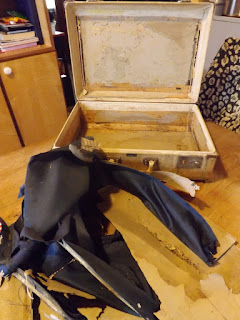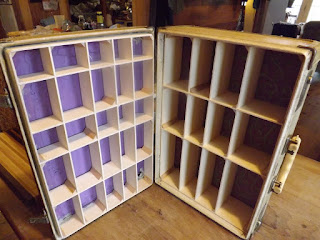Making homemade soap is fun and open to endless, creative interpretations.
Photo credit: Richard Karper
One of the most frequent comments I hear when someone is interested in my handmade soaps goes something like this: "Oh, I just love this natural soap! I remember my grandmother used to make that awful lye soap but I just like using the natural stuff." This is a bit of a riddle because all soap, by definition, is the result of the reaction between fats and oils and sodium (or potassium) hydroxide, or as it is more familiarly known: lye. Simply put: no lye, no soap.
A variety of both liquid and solid fats, ranging from Coconut to Olive, and many others, can be used in natural soap-making.
A solution of lye crystals in water is also essential in soap-making.
Perhaps because common lye is also known by the somewhat ominous-sounding name of sodium (or potassium in the case of liquid soap) hydroxide, and the current popular perception is that "natural" and "chemical" are mutually exclusive terms, many associate lye soap with harshness and austere frugality. But let's make our high school chemistry teachers proud and demystify the whole soap-making process.
The first step is to overcome our misconceptions about chemicals and re-frame them as yet another way to talk about everyday, common items with which we are familiar. Some rascally (and witty) scientist with a bit of spare time in the lab came up with the following information in the interest of public safety. Read along and see if you can identify this common chemical:
Dihydrogen Monoxide (DHMO) is a colorless and odorless chemical compound, also referred to by some as Dihydrogen Oxide, Hydrogen Hydroxide, Hydronium Hydroxide, or simply Hydric acid. Its basis is the highly reactive hydroxyl radical, a species shown to mutate DNA, denature proteins, disrupt cell membranes, and chemically alter critical neurotransmitters. The atomic components of DHMO are found in a number of caustic, explosive and poisonous compounds such as Sulfuric Acid, Nitroglycerine and Ethyl Alcohol.
For more detailed information, including precautions, disposal procedures and storage requirements, refer to one of the Material Safety Data Sheets (MSDS) available for DHMO.
If you have guessed what this chemical compound is (and you are chuckling to yourself), give yourself a gold star and move to the head of the class. Yes, Dihydrogen Monoxide (DHMO) is good old-fashioned water, couched in the language of science. You can read the entire, highly entertaining, text, precautions, and safety guidelines here if you like: http://www.dhmo.org/facts.html
My point is that just because something is called by its scientific name is not necessarily cause for alarm. The language of science can be every bit as fun as Pig Latin was as a kid if we choose to play along. So, back to soap...
Soap, quite simply, is the result of a chemical reaction between fats (or lipids, as a scientist would say) and lye (Sodium Hydroxide) often driven by heat, in one form or another, over time. All of that can be written using letters, numbers, and symbols if one takes a playful fancy to that sort of thing. Maybe you are wondering about what you have heard about lye and its caustic qualities. That is absolutely true. It is indeed caustic and should be used with care and presence of mind while wearing protective gloves and safety goggles. I am never sure how to address the fear that many express in handling lye. It is true that it is not a time for goofing off or being inattentive but that is also true of making a pot of soup. Sharp knives for chopping meats and vegetables, hot burners, and simmering liquids on a stove all pose a risk and should be handled responsibly but I haven't met anyone yet who has opted not to eat because preparing a meal could be dangerous. Making soap basically requires the same skill set. Educating myself and then proceeding with due sobriety and awareness has proven sufficient for me so far.
Fats/Oils along with a lye solution reacting in a process called 'saponification' that will result in SOAP!
Back to the lye Grandma used to make soap to meet the cleaning needs of home and hearth. What is lye, besides Sodium (or Potassium) Hydroxide, as if that clarified anything, and how was it made? The history of soap-making is long and interesting but I will step into the flow of that story at the point of Early America. Settlers couldn't order their supplies from Amazon or soap-making companies as I can today, nor could they nip out to the nearest big box store for a jumbo pack of Ivory. Undaunted, they gathered the hardwood ash from their fireplaces and combined it with rainwater to produce an alkaline solution we would call lye water. Hold on to your alchemical wizard's hat because wood ash is an excellent source sodium (a salt), especially sodium and potassium hydroxides and carbonates, all forms of alkali. Rainwater was allowed to trickle through a bucket of sifted hardwood ashes and the resulting liquid that leached out was the lye mixture used, along with rendered fat, to make soap to meet the cleaning needs around the homestead. In 1791 a French chemist named LeBlanc, which ironically means 'the White', invented a process of making soda ash by electrolytic reaction, allowing for the production of uniform, hard bars of soap to be produced and eventually leading to that wonder of wonders, the Ivory soap bar that floats. Fascinating!
Post World War II, factory soap production actually shifted to detergent production as companies sought to find new uses for a whole new arena of synthetic chemicals. According to THE SOAPMAKER'S WORKSHOP: The Art & Craft of Natural Handmade Soap by Dr. Robert S. [a retired chemist] and Katherine J. McDaniel, the Tide company, "...produced [their product] by sulfonation of the condensation reaction of benzene with olefins. Tide was introduced the same year as the automatic washing machine cleaner. Over the next 30 to 40 years, synthetic detergents took over the washing detergent market and then began dominating the bar soap market as detergent bars were introduced...What is usually considered to be soap is either a synthetic detergent (syndet) in compressed solid form or a blend of soap with synthetic detergent (a combar)."
In a nutshell, I do something closer to what Grandma did back in the day, although I use a crock pot and often purchase my sodium hydroxide in bulk. I find soap-making creative, useful, and just good, clean fun as well as an interesting science lesson.
Bubbles!



























